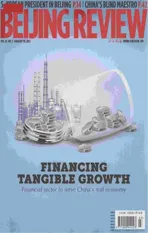A New Stage of Urban Construction
2012-10-14本刊编辑部
A New Stage of Urban Construction
Since Xiamen is located at the front of coastal defenses, its infrastructure was outdated. Therefore, the SEZ tried to improve its investment environment, innovate its investment and financing mechanisms, actively attract capital from various sources and accelerate urban construction with infrastructure as the framework, such as transportation networks, information networks, and power, gas and water supply systems. From 1981 to 2010, the city completed accumulative fixed assets investment of 705.8 billion yuan ($112 billion), an average annual increase of 24.4 percent, which has powerfully driven up local economic growth.
Infrastructure
In the past three decades, Xiamen has given priority to infrastructure construction, greatly improved the city’s water, gas and power supply capacity and almost eliminated the problems that bother the city’s economic development. From 1981 to 2010, Xiamen completed accumulative fixed assets investment in infrastructure of 227.01 billion yuan ($36.03 billion), accounting for 32.2 percent of the city’s total fixed assets investment. According to the Revised Urban Planning of Xiamen, the city has accelerated expansion of the new urban area to the gulf outside Xiamen Island, and the area of the city was expanded from 38.5 square km to 230 square km in 2010. Xiamen has also allocated funds to build and expand urban water and power supply projects. The city’s total water supply capacity was increased from 30.49 million tons in 1981 to 316.66 million tons in 2010. Total electricity consumption of the city increased from 252 million kwh to 15.06 billion kwh in 2010. Gas supply mainly depends on pipeline gas supplemented with bottled liquid gas. In 2010 natural gas supply of the city was 90.85 million cubic meters and liquid gas supply was 90,000 tons, with gas supply accessing 100 percent of urban households.
Transportation

Urban scenery
In the past three decades, Xiamen has been improving its transportation capacity, accelerating construction of express passages connecting areas inside and outside the SEZ and connecting the SEZ and other cities, and completing the networks of intercity expressways and urban transportation networks of the island. Since the transportation time between Xiamen and other cities is shortened, a “one-hour economic circle”has been formed, promoting cooperation and exchange between Xiamen and 13 surrounding cities and strengthening the city’s influence as a regional center. The total length of urban roads increased from 104 km in 1981 to 1,213 km in 2010, and the total area of urban roads increased from 790,000 square meters to 22.94 million square meters. The number of public transportation vehicles of various types rose from 93 to 3,363 and the number of taxis increased to 3,646. Xiamen now ranks among the best in the country in terms of transportation convenience.
New urban area
In recent years, Xiamen has broken the structure of imbalanced development and has vigorously enhanced integration of areas inside and outside the island, completing the planning for a 71-square-km core area covering four new urban areas outside the island, namely, Jimei, Haicang, Tong’an and Xiang’an. At present, all rural areas in Xiamen have been upgraded to urban areas, and urbanization process in rural areas is accelerating. Xiamen ranks among the top in the country in integration of urban and rural areas. Since 2005 the total fixed assets investment outside the island has surpassed that inside the island. In 2010 fixed assets investment outside the island reached 61.09 billion yuan ($9.7 billion), accounting for 60.5 percent of the city’s total fixed assets investment.
Real estate industry
Since the establishment of the SEZ, the real estate market of Xiamen has stepped to a stage of prosperity, with the investment volume continuously rising and the sales volume of commercial buildings growing. In 2010 Xiamen completed 39.61 billion yuan ($6.29 billion) of fixed assets investment in real estate, accounting for 39.22 percent of the city’s total. Of this, investment in commercial houses was 20.74 billion yuan ($3.29 billion). A total of 4.27 million square meters of commercial buildings were sold, of which 70 percent are commercial houses. At present, the percapita housing area for urban residents in Xiamen has reached 32.17 square meters and that for rural residents is 52.9 square meters.
Environment
Xiamen has formed a framework for a modern and international scenic port city with a beautiful environment and complete infrastructure, and realized the goal of “seeing green” by walking 500 meters and reaching a park by walking 15 minutes. By the end of 2010 the per-capita green area in the city had reached 19.35 square meters. The city now boasts 66 parks, covering 2,046 hectares, and afforested areas covering 9,293 hectares, or 40.4 percent of the total urban area. In the meantime, Xiamen has strengthened public management to improve city environment, the coast belt and scenic resources and taken comprehensive measures to harness urban lakes and reduce air and water pollution. Over the years, Xiamen has received the honors such as National Hygienic City, National Garden City, National Excellent Tourism City, National Water Saving City, National Top 10 Habitat City, International Garden City, National Environment Protection City, United Nations Habitat City, Best Investment City for Multinational Companies and National Civilized City. Xiamen has become one of the best cities to live in China.
